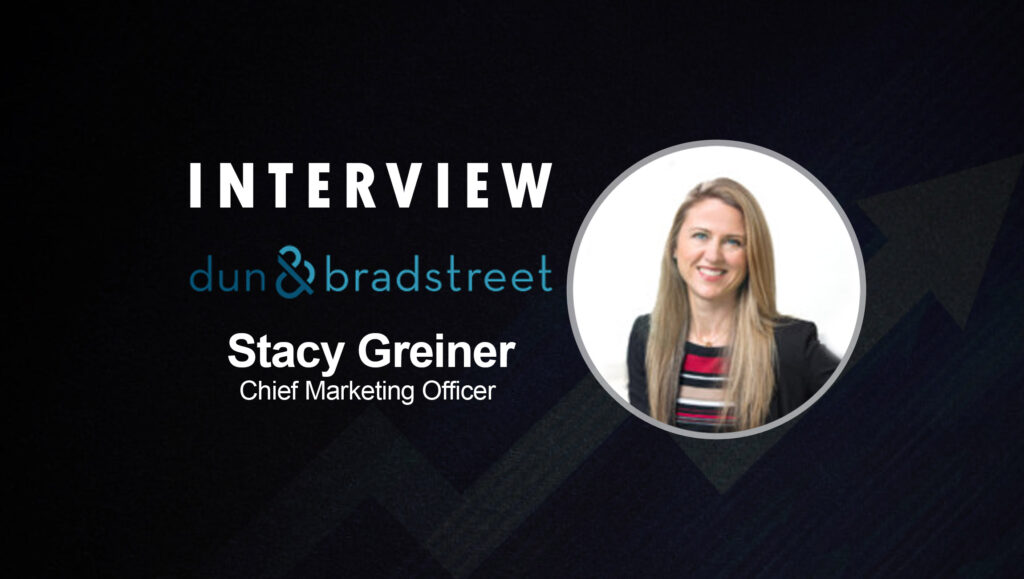We need to remember there is a human side to business as things change during this new normal due to the Covid-19 pandemic. While we still need to conduct business, showing a little grace to our co-workers, customers, partners, and suppliers is something that can’t be measured on a spreadsheet. The pandemic isn’t going to last forever, but it will forever change the way we work and live. How can your business be one that manages to pivot to meet changing demands in time and thrives despite the pandemic? Stacy Greiner, Chief Marketing Officer at Dun & Bradstreet comments.
_____
Tell us a little about yourself, Stacy? You’ve had an incredible journey in Sales / Technology Sales and associated roles so far – we’d love to know some highlights.
I started my career as an aerospace engineer and software developer; following an MBA from MIT, I brought my analytical bent to Marketing where I have spent the past 17 years transforming Marketing organizations into data-driven growth engines. Joining Dun & Bradstreet earlier this year has been an amazing opportunity not only to bring this passion to our own Go-to-Market organization, but also to support our customers in their own transformation journeys with our data-driven Sales & Marketing solutions.
Could you tell us a little about Dun & Bradstreet’s recent B2B marketing and sales data report: what are some of the findings you’d like to throw light on?
This is the 7th year we’ve run this report and have seen a real shift over the course of time in the perceived importance of data quality. When we first started, sales & marketing teams weren’t sure of the value of quality data for their programs. Now, they see it as a necessity.
What remains a challenge for marketers is using data to drive some of the more complex campaign strategies, like account-based marketing (ABM), for instance. ABM is critical for Marketing teams tasked with doing more with less, but many struggle with targeting and activation of cross-channel campaigns. This is why we continue to invest in both higher quality data and an ABM platform that helps our customers more easily target and activate.
Read More: AdLedger Announces CryptoRTB Protocol For Digital Advertising
There’s always been a lag between data quality and aligning it to marketing or sales strategies: what are your top tips for alleviating this problem?
Marketing and sales first need to set goals together. If each team is not working towards the same goals, it really doesn’t matter what technology or data is being used, because both teams will be headed in different directions.
Build a solid data foundation. All data is not created equal. You need quality data on which to run your analytics and make decisions. Garbage in/garbage out is very true here.
Connect the data across your business. Sales & marketing teams need to be working from the same view of the customer at any given time and sharing that customer data across systems is the only way to effectively do that. Consider investing in a Customer Data Platform (CDP) that will allow you to really understand customer needs at each stage of the journey.
Use data to activate the campaigns that fit your marketing strategy. This goes beyond basic data and requires layering in attributes like fit, intent, and even risk to your analysis. Lastly, measure your results and make adjustments.
Read More: SalesTechStar Interview With Greg Harbinson, Group Strategy Director At Centerline Digital
What are the top 5 tips you’d share with technology marketing and sales teams today, (given the current world situation due to the Covid19 pandemic): how would you advise them to tide over the current business challenges due to the pandemic?
We know that, based on a scan of about 100 of our customers’ pipelines, 30% of those pipelines are currently experiencing some sort of risk. That’s up from 21% in May. But there are opportunities to change the way you think about sales and marketing during times like this and those changes could actually be something that you want to continue long-term. Here are five things to consider as ways to pivot during this pandemic:
- Assess how customer needs have changed and meet customers where they are today. We see examples of this everywhere. Companies changing what they produce, how they produce it, how it’s delivered or accessed- all to meet customers where they are in this changed world.
- Lean into Account Based Marketing. Never has it been more important to do more with less, and the teams who are leaning into ABM realize the benefits of focusing attention and resources on the prospects and customers who are most likely to convert. Use good account data to identify the best targets, get alignment on targets between Marketing and Sales, and leverage an ABM platform that allows you to coordinate campaign activation across channels.
- Incorporate risk into your targeting. By understanding which accounts are at risk in your pipeline, you can focus activities and resources accordingly. You can either stop spending money on marketing to those accounts or you could figure out new solutions to help those customers who are at risk.
- Reduce spend on high-contact activities. This doesn’t necessarily mean shifting everything to virtual events. This is the time for your sales and marketing teams to work together to test new tactics and measure their success.
- Help sales by creating deep content that truly enables customers to solve problems and positions you as a thought leader.
When it comes to building a skilled marketing and sales team in tech today, and given the constant evolving salestech and martech space – what are some of the strategies you follow when it comes to upskilling the taskforce or hiring/building a team that can adapt and evolve with the changing demands of the role and the tech?
With the pace of transformation, Marketing and Sales teams are challenged with knowing how to adapt, understanding which technology will actually be helpful, organizing for success, and integrating existing technologies and workflows. Now more than ever, our customers look to us not only for technology solutions but also for best practices. The most important skill I look for is subject matter expertise- how can you help our customers rather than just sell to them? How can you use your expertise to move with agility and confidently ensure our customers are successful?
What are some of the biggest challenges you see tech sales teams in larger companies face, despite possibly having a good salestech stack: how would you advise them to overcome these challenges?
The stack is only as good as the data feeding it and the connectedness to the rest of the organization. One of the main issues large companies have is that sales and marketing teams aren’t sharing customer information in the same system, so they don’t have the same view of the customer at any given time. It’s important that both teams are seeing the most up-to-date information about a customer and then layering on intelligent analytics that show customer intent, fit, and even pipeline risk.
A little change of pace…what according to you are some of the top factors businesses with a remote and distributed workforce should consider most given the current world situation and the need for a secure remote work environment?
We all tend to look at the technology needs first; and those are important. Of course teams need the proper equipment, wifi, and access to company systems from home. But I have found that it’s the personal interaction that’s actually more important during times like this – overcommunicating the path to success, a clear set of goals and roles, and frequent check-ins. Having joined Dun & Bradstreet the week after the offices closed, I’ve actually met very few of my colleagues in person. While video has been great to support building new relationships, I’ve found it’s more important than ever to carve out time for overcommunicating. We even started a weekly “Espresso Yourself” series where I sit down to share a virtual coffee with a handful of people at a time from across the team to hear how things are going on the ground and keep everyone personally connected to our joint goals.
Tag (mention/write about) the one person in the tech/startup/salestech industry whose answers to these questions you would love to read!
Mike Riegel, President at CloudFactory, who continually challenges his teams to think differently.
Your favorite Sales/SalesTech quote and sales leadership books you’d suggest everyone in Sales reads
One of my more recent favorites is The Infinite Game by Simon Sinek. In the fast pace of the tech industry, we’re so quick to talk about winning and beating the competition, but he does a great job of framing why “infinite” vs “finite” thinking leads to more trust, innovation, and long-term growth.
Before we wrap up, tell us about some of the top sales/salestech/fintech/ other (virtual) events that you’ll be participating in (virtually, given the current global pandemic) (as a speaker or guest!) in 2020!
We have a mix of events we’re both sponsoring and hosting this Fall. One of the largest and most comprehensive events we’re hosting is the Revenue Acceleration Summit which just concluded yesterday on September 16th.
Read More: SalesTechStar Interview With William Tyree, Chief Marketing Officer At RingDNA
______
In what ways are leading Sales and Marketing teams adjusting to the new normal? Catch our latest episodes of The SalesStar Podcast where we feature thoughts from Acoustic, Partnerize, AspireIQ, Upland Marketing Cloud and more!
Dun & Bradstreet data and insights help improve your business performance. Delivered through the Dun & Bradstreet Data Cloud and their market-leading solutions, their data and insights help accelerate revenue, manage risk, lower cost and transform everyday business. Global businesses of all sizes rely on Dun & Bradstreet’s data, insights & analytics.
As the CMO for Dun & Bradstreet, Stacy is responsible for driving growth leading all aspects of Communications, Marketing, and Inside Sales as well as redefining the role and scope of Marketing as a partner in business effectiveness.






















